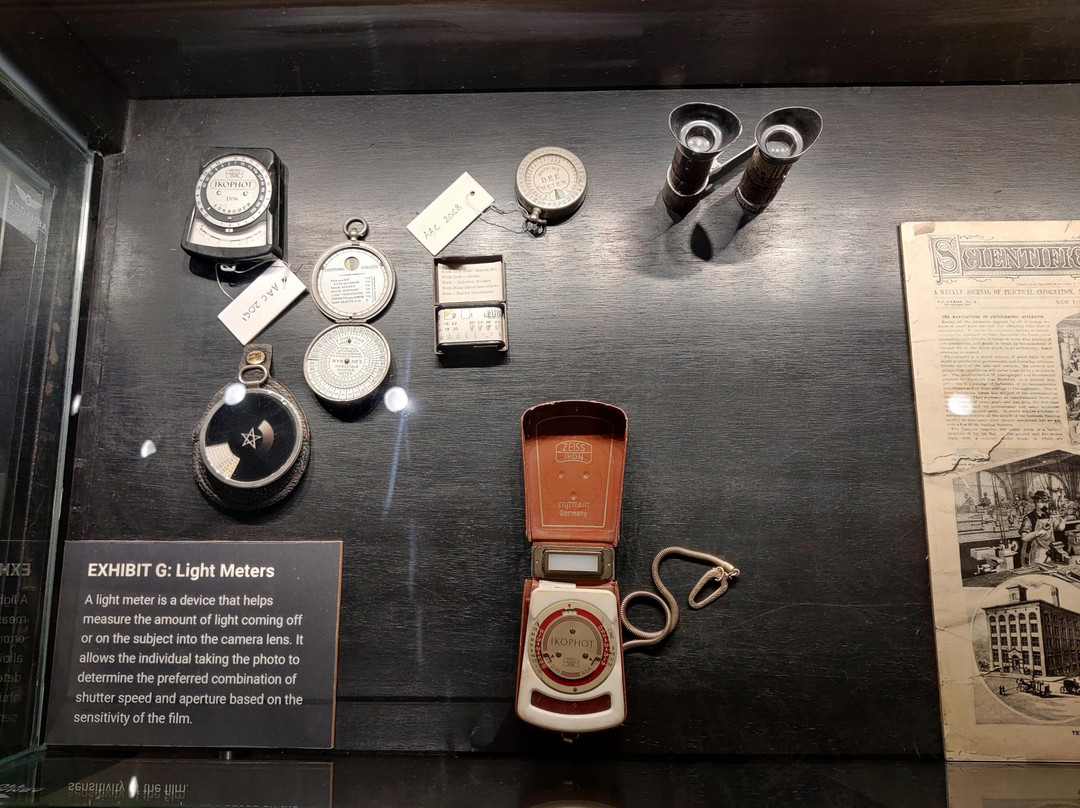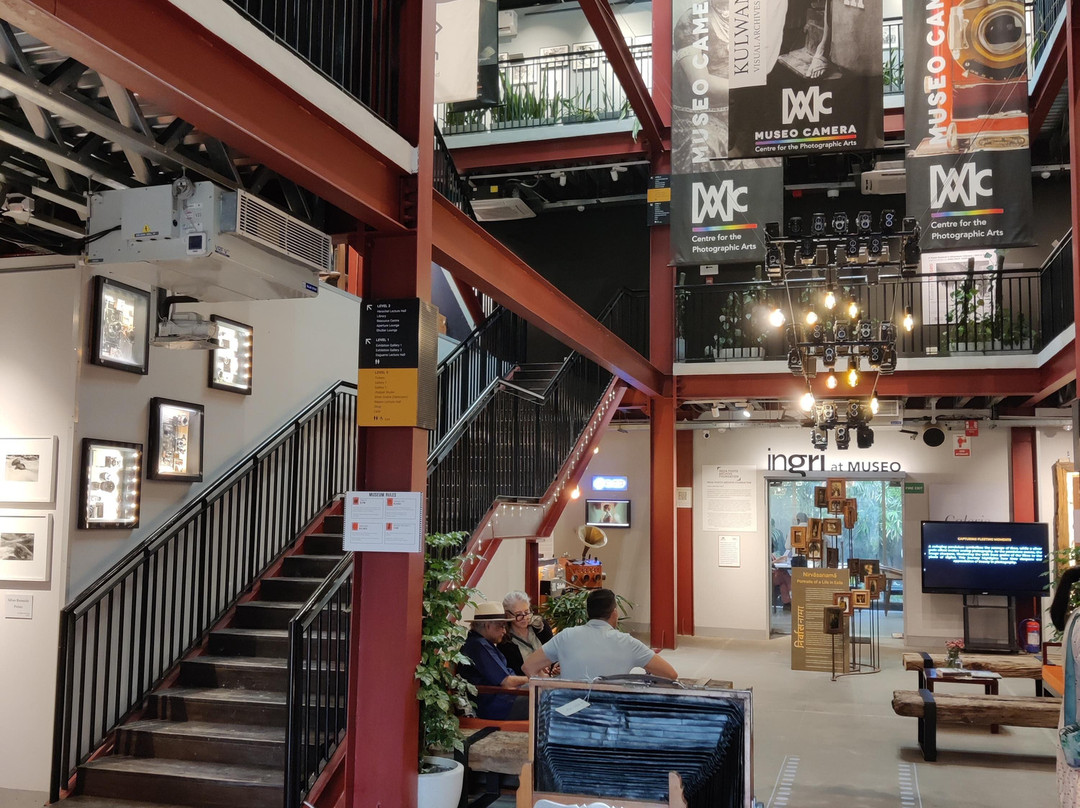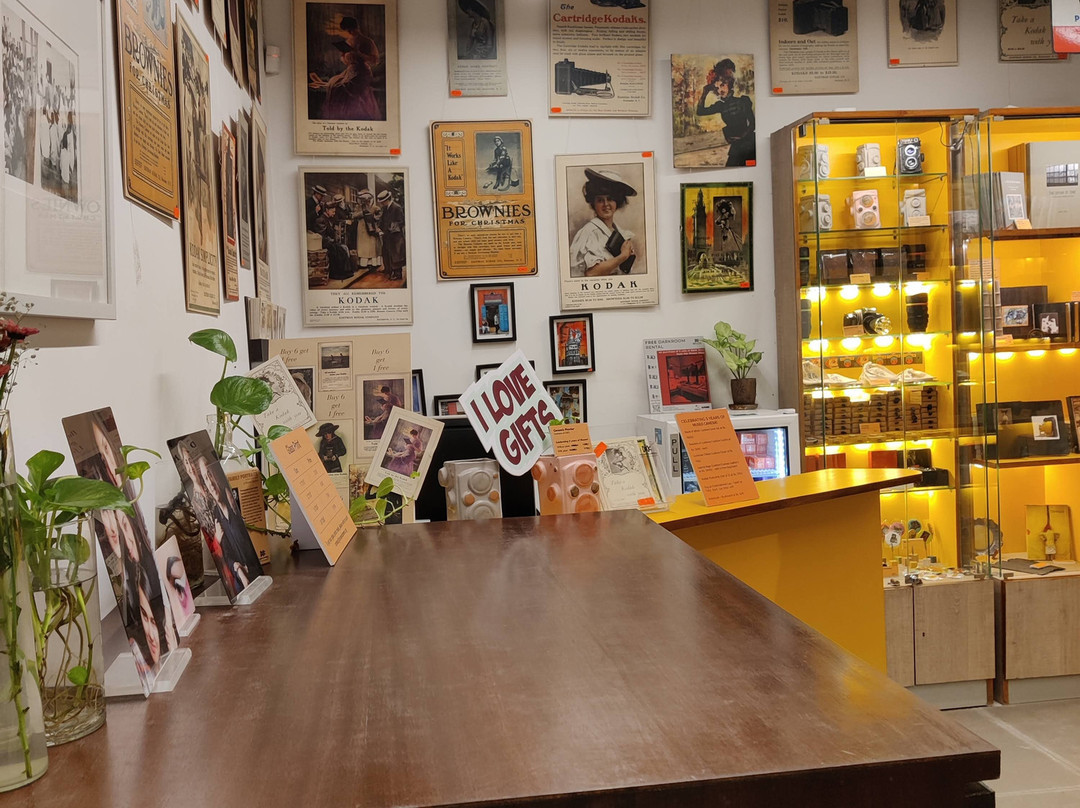的点评
A fine tribute to photography
Museo Camera的点评
点评:Photographer Adita Arya, over many decades of work, collected thousands of artefacts related to photography: these artefacts form about 97-98% of the display at Museo Camera, which he first set up in 2006, and which has since expanded. The museum is housed in a building that stretches over several floors and includes, besides the museum, various other areas: research centres, a dark room, lecture halls and conference rooms, studio, the museum shop, and a café. Outside, the garden has some delightfully quirky brightly-painted stuff—auto rickshaw, scooter, Ambassador car—designed for visitors’ selfies.
The museum spreads over two galleries on the ground floor; basic ticket prices are Rs 200 per person above 9 years. You pay extra for an audio guide. Photography is not just allowed, but encouraged! On the second floor of the building is a permanent exhibition of some stunning works by Kulwant Roy, whose portraits of Gandhiji and other national leaders of the mid-century are iconic. The first floor has two galleries where temporary exhibitions are hosted; when we visited, one exhibition had photos from the early 1900s of a mountaineering expedition in the Himalayas; the other was of 19th century Lucknow courtesans.
The museum’s galleries basically use a timeline method to show the development and evolution of photography. Well-written text, lots of interesting artefacts (cameras, photos, accessories, and more) are arranged here in what is a treasure trove devoted to photography. There are amazing insights into pioneers, major brands, specialized cameras (for war; spy cameras; Polaroid; etc), stereoscopes, and more.
You need at least an hour to even do a rudimentary tour through the museum. It’s very interesting, and the professionalism with which everything has been curated, described, and displayed, is admirable. One of the best museums I’ve been to in India.
The museum spreads over two galleries on the ground floor; basic ticket prices are Rs 200 per person above 9 years. You pay extra for an audio guide. Photography is not just allowed, but encouraged! On the second floor of the building is a permanent exhibition of some stunning works by Kulwant Roy, whose portraits of Gandhiji and other national leaders of the mid-century are iconic. The first floor has two galleries where temporary exhibitions are hosted; when we visited, one exhibition had photos from the early 1900s of a mountaineering expedition in the Himalayas; the other was of 19th century Lucknow courtesans.
The museum’s galleries basically use a timeline method to show the development and evolution of photography. Well-written text, lots of interesting artefacts (cameras, photos, accessories, and more) are arranged here in what is a treasure trove devoted to photography. There are amazing insights into pioneers, major brands, specialized cameras (for war; spy cameras; Polaroid; etc), stereoscopes, and more.
You need at least an hour to even do a rudimentary tour through the museum. It’s very interesting, and the professionalism with which everything has been curated, described, and displayed, is admirable. One of the best museums I’ve been to in India.
翻译:摄影师 Adita Arya 经过数十年的工作,收集了数千件与摄影相关的文物:这些文物占到他于 2006 年首次建立的摄影博物馆展品的 97-98%,此后规模不断扩大。博物馆坐落在一座横跨数层的建筑内,除了博物馆外,还包括其他各种区域:研究中心、暗室、演讲厅和会议室、工作室、博物馆商店和咖啡馆。外面的花园里有一些色彩鲜艳、令人愉悦的古怪玩意儿——自动人力车、踏板车、大使车——专为游客自拍而设计。
博物馆分布在一楼的两个画廊;9 岁以上的基本票价为每人 200 卢比。您需要额外支付语音导游费用。这里不仅允许拍照,而且鼓励拍照!大楼二楼是库尔万特·罗伊一些令人惊叹的作品的永久展览,他为甘地和二十世纪中期其他国家领导人拍摄的肖像画具有标志性。一楼有两个画廊,用于举办临时展览;我们参观时,一个展览展出了 20 世纪初喜马拉雅山登山探险队的照片;另一个展览展出了 19 世纪勒克瑙妓女的照片。
博物馆的画廊基本上使用时间轴方法来展示摄影的发展和演变。精心撰写的文字、大量有趣的文物(相机、照片、配件等)都在这里排列,这是一个专门用于摄影的宝库。这里有关于先驱者、主要品牌、专业相机(用于战争;间谍相机;宝丽来等)、立体镜等的惊人见解。
即使是参观博物馆,您也需要至少一个小时的时间。非常有趣,所有东西的策划、描述和展示都十分专业,令人钦佩。这是我在印度参观过的最好的博物馆之一。
博物馆分布在一楼的两个画廊;9 岁以上的基本票价为每人 200 卢比。您需要额外支付语音导游费用。这里不仅允许拍照,而且鼓励拍照!大楼二楼是库尔万特·罗伊一些令人惊叹的作品的永久展览,他为甘地和二十世纪中期其他国家领导人拍摄的肖像画具有标志性。一楼有两个画廊,用于举办临时展览;我们参观时,一个展览展出了 20 世纪初喜马拉雅山登山探险队的照片;另一个展览展出了 19 世纪勒克瑙妓女的照片。
博物馆的画廊基本上使用时间轴方法来展示摄影的发展和演变。精心撰写的文字、大量有趣的文物(相机、照片、配件等)都在这里排列,这是一个专门用于摄影的宝库。这里有关于先驱者、主要品牌、专业相机(用于战争;间谍相机;宝丽来等)、立体镜等的惊人见解。
即使是参观博物馆,您也需要至少一个小时的时间。非常有趣,所有东西的策划、描述和展示都十分专业,令人钦佩。这是我在印度参观过的最好的博物馆之一。










此点评仅代表旅行者个人的主观意见,并不代表TripAdvisor以及其合作方的意见。
关于我们
|新闻动态
|商务合作
|会员中心
|业主中心
|常见问题
|意见反馈
|联系我们
|营业执照
© 2025 Tripadvisor 版权所有。
使用条款 |隐私政策 |网站工作原理
部分照片由 VFM Leonardo 提供。
* Tripadvisor不是旅行社,也不是旅游预订服务代理商。我们提供免费、客观、公正的旅游资讯服务。 (显示更多)
TripAdvisor LLC 既不是预订代理商,也不是旅游运营商,不会向网站用户收取任何服务费。 按照规定,在 Tripadvisor 发布机票价格、游览和旅行套餐的合作伙伴(航空公司、旅行提供商及预订代理商),其标价须包含所有费用和附加费用。 例如, 机场出入境税费、消费税与其他服务费、手续费、杂费及附加费用。 当您向我们的某个合作伙伴进行预订时,请务必查阅他们的网站以了解当地行政部门要求的所有适用费用的具体情况。 除非另有说明,机票价格通常指的是一个人的价格(以人民币计)。
为方便起见,TripAdvisor LLC 根据从我们的预订合作伙伴获取的空房率计算每个酒店的均价。 对于游览和景点来说,所显示价格通常是每位成人的最低可用价格。 对于列出的任何旅行套餐或优惠,TripAdvisor LLC 无法保证任何特定的费率或价格。 此外,酒店均价每晚会更新,并以您的首选币种表示(使用现行汇率)。 由于这些已换算的价格是预估价格,因此,有关具体金额和币种请与预订网站进行核实。
此外,TripAdvisor LLC 无法保证我们网站上宣传的价格随时有效。 标价可能需要预订一定天数才能生效,或有不可用日期、使用条件或限制。
TripAdvisor公司对外部网站的内容一概不负责。优惠价格中不含税和其他费用。
ICP证:沪B2-20200433
沪ICP备20013175号
 沪公网安备31010502005427号
沪公网安备31010502005427号鹰程信息技术(上海)有限公司
货币/国家及地区
¥CNY
中国

